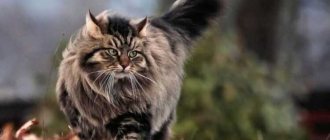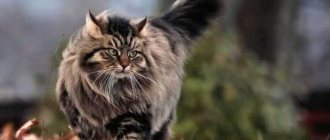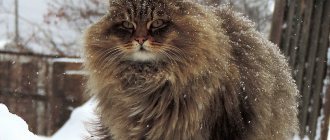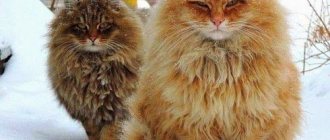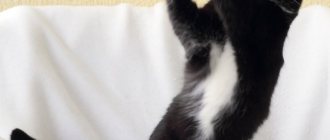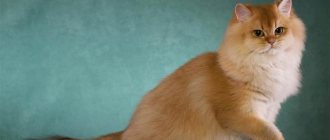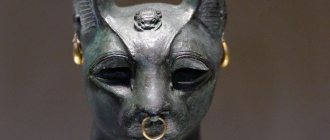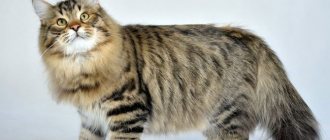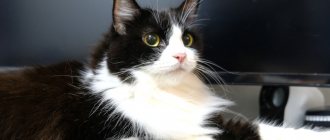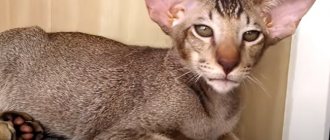In terms of popularity and success, the Siberian cat occupies almost a leading position among other breeds.
Representatives of the species are often credited with Russian roots, although in fact their ancestors were exclusively Asian cats.
And yet, even their foreign origin did not prevent them from winning the respect and title of real Russian heroes, whose goal is to protect housing by any means, to help its inhabitants in everything and to expand their habitat right up to the most extreme borders of not only our state, but to climb beyond its borders.
Breeders, in turn, repeatedly ask questions. For example, is it possible to pay attention to this fluffy beauty if there are children in the house? What are representatives of the Siberian cat breed like? How to properly care for and feed your pet for complete happiness?
It's time to reveal all the ins and outs and dispel existing myths about these charming creatures, leaving room for the truth.
Origin story
Despite its name, the grandmothers of the Siberian cat are considered to be people from Asia. Traveling with traders, Bukhara cats reached Siberia and, together with merchants, began to develop vast territories.
Local residents willingly bought animals for their dexterity and dexterity in fighting rodents. Gradually, Bukhara cats became close to representatives of local wild breeds, and their kittens acquired fluffy and warm skin and excellent hunting skills.
It is believed that the first representatives of this breed appeared in the east of the Urals and gradually spread throughout the cold region. The first mention of these animals was recorded in written sources of the 16th century.
In any photo, a Siberian cat shows all the charm of the fluffy breed.
Standards
The appearance of the Siberian cat is impressive: its body is powerful, large, covered with thick and long hair. Females weigh 4-5 kg, the weight of an adult cat is much larger - 7-8 kg, and sometimes reaches up to 12! These are real long-livers - sometimes they live up to 20 years.
| Standard | Description |
| Head | Trapezoidal, with smooth lines. There is no clearly defined “stop”. The chin is clearly defined, as are the cheekbones, and the cheeks are round and full. |
| Ears | Wide at the bottom, triangular, with rounded tips. They are slightly inclined forward, pubescent both outside and inside. |
| Eyes | Oval, very expressive. Small, but open. Placed slightly obliquely, widely. Iris color: yellow or green (all shades). |
| Torso | Massive, with a wide back and a strong rear. The chest is voluminous, the neck is muscular and short. The paws are thick, of medium length, with well-developed muscles. The paws are round and wide, flattened. The fur grows in tufts between the toes. |
| Tail | Long and shaggy, tapering towards the tip. |
| Wool | The coat is very dense. The undercoat is very soft and delicate to the touch (due to the fact that the texture of the hairs is thin). The top layer of wool is stiffer, grows evenly, and in the area of the sides and tail seems to “fall” down. Siberian wool repels moisture well. By winter, the “fur coat” becomes thicker and shinier, especially in the area of the “collar” and “panties” on the hind legs. |
Significant disadvantages of the breed:
- “Bare” fingers;
- Coat growing in tufts and dull, lack of undercoat;
- Tail with bald spots, short or too long;
- Eyes that are too big or small;
- Ears too small or large;
- Flat cheeks, elongated muzzle, long thin neck, poorly developed bones.
Character of the Siberian cat
Smart and quick-witted representatives of this breed, like true Siberians, are friendly and sociable. Although they can show their character on the other side - pride and independence also correspond to the description of this breed.
For recommendations on caring for cats at home, see the portal about animals https://zhivotnyeplanety.ru/.
Cats become very attached to people, although they do not like strangers, especially if they pick the cat up without permission. And they won’t allow their owners to squeeze them too much.
They treat children well, but will not allow them to hurt themselves.
Siberians are not a picky breed at all. They will play with whatever their owners offer them or get a toy on their own. This could be an ordinary candy wrapper, a piece of paper or rope.
A well-developed hunting instinct allows them to protect homes from rodents. There are known cases when such hunters, left without prey, caught ferrets and rabbits.
Siberian cats have well-developed jumping ability, so if the owners do not see the cat on the floor, they should inspect all the cabinets - the hunter can monitor the situation from above.
The Siberian breed can be used as watchdogs - they will selflessly defend their territory and are wary of strangers.
They are not afraid of dogs and can start a fight with them if they think that they have violated territorial boundaries. They are also not afraid of sharp sounds.
Siberians are considered calm and balanced animals, although the Siberian cat kitten loves to play and be naughty. Some cats retain their lively character even into adulthood.
The roots of wild cats will not allow her to adapt to a person; she will still remain in her opinion and will not follow people, asking for attention and affection.
But they will not leave the owner if he is sick or upset. To become a real owner for such a cat, you must respect the requirements and dignity of the animal.
- Animal cremation.
- What are the benefits of grooming animals?
Ultrasound of animals. Why is it made?
Survival in the harsh conditions of Siberia has developed prudence and intelligence in these cats. She will think first and then act.
The Siberian breed is excellent for private homes, where it is given opportunities for hunting and walking. A cat living in the city should be taken for walks regularly.
It is advisable to wear a harness so that the animal does not run away, driven by hunting instincts.
A pet of this breed must have its own place - a house or a bed - where no one will touch it. A multi-tiered cat house is well suited for this purpose, in which the animal can play and sleep.
How much does it cost to choose and care for a kitten?
Kittens of the Siberian breed are not uncommon nowadays. They can often be found walking in the yard. It is better to purchase a baby from a nursery or from a familiar breeder. This is the only way to be sure that your baby has received the necessary vaccinations.
The cost of a Siberian kitten depends on the color of the coat. The price of purebred representatives can reach 10–30 thousand rubles.
It is quite simple to distinguish a Siberian kitten from an ordinary one. The babies are large in size, they are strong, with powerful paws. The tail is very fluffy. Another distinctive feature is the fluffy collar. The change of teeth in kittens begins at 3–4 months.
As for the name, this is at the discretion of the animal’s owner. You can name the cat a girl: Umka, Tigger, Taiga. Also common cat names for girls: Athena, Artemis, Bast, Bessie. A suitable nickname for a boy: Boniface, Baron, Marquis, Ermak, Push or Pushok, Stefan. The cat can also be named: Caesar, Romka, Boris.
Kitten weight by month
The table below will help you determine how much a kitten should weigh.
| Age | Kitten weight by month boy | Girl |
| Newborn | 110 grams | 100g |
| 2 months | 3 kilograms | 1.5 kilograms |
| 5–6 months | 5–6 kilograms | 2–3 kilograms |
| 12 months | 5–7 kg. | 3–4 kg. |
An adult Siberian cat can weigh up to 12 kilograms. Siberian kittens, unlike other cats, grow for quite a long time. The animal reaches full maturity by 4 years of its life.
Training
The Siberian cat is quite smart. With some persistence, you can teach her to fetch things and follow a few simple commands.
When training, you should not shout at the animal; this can ruin the entire learning process and discourage the desire to learn commands. It is better to use affection and encouragement.
- Where can I take veterinary courses and what are they for?
- Akita Inu. What kind of breed is this and what are its characteristics?
- Siamese cat - description of the breed, character and features of caring for Siamese cats (105 photos and videos)
Description of the Siberian cat breed
The animals have a strong, muscular body and have magnificent thick fur that protects its owner during frosts.
With the onset of cold weather, the fur coat becomes even warmer, and winter pants and a collar appear. Due to its special properties, the animal’s fur does not get wet very well.
The colors of the Siberian cat can be very diverse. White and black, silver and blue, brindle and tortoiseshell, two- or three-color colors are acceptable here.
Colors
These pets have about two hundred color options, but not all of them correspond to the standard. They can be divided into the following groups:
- tortoiseshells,
- smoky,
- plain,
- colorpoint,
- two-color,
- tabby
Kittens are born with blue eyes, which change over time according to genetics. Solid colors of Siberians are characterized by a uniform coat tone and the absence of spots. The furs are dyed along the entire length. The eyes are amber or copper, but can also be blue. In this group, the most popular colors are blue, white, black and red. Tortoiseshells are a combination of three colors, while tabbies are striped.
The smoky color looks great, and chinchillas also belong to it. Smoky fur shimmers in the sun, and these cats have light eyes. Chinchillas are more reminiscent of silver, their fur is very delicate, they seem to be shrouded in fog.
The colorpoint color includes light and dark colors, the body is light, but the paws, tail and muzzle are darker. The most popular in this group are Neva masquerade individuals. They have cream-colored fur and darkened limbs and ears. There is a mask on the face. Two-colored animals always have white spots. The delicate shade should occupy approximately one third of the entire body, and the boundaries should be clear.
brindle
In other words, it's a tabby. These animals resemble real tigers, but they do not have to be red.
There is, for example, a very original black brindle color. Breeders pay a lot of attention to the correct placement of stripes. At the same time, the letter “M” is clearly visible on the cat’s forehead, stripes on the back and sides, continuous ringing “necklaces” on the neck, stripes stretch from the back to the stomach. Two rows of dots of the main color are visible on the abdomen.
To read: Features of care and feeding of the Estrela Shepherd breed, reviews from owners
These kisuls have very bright eyes, most often light yellow or light green, they are emphasized by rimming and look very expressive. Their tail is also very cute, reminiscent of a raccoon. The base color can be anything, but most often it is light brown. This skin helped the wild ancestors of these beauties to camouflage themselves in forests, steppes and among tall autumn grass.
Tortoiseshell
It consists of a combination of solid colors, when large spots are located on the body. As a rule, it occurs only in females.
They look very bright, variegated, but at the same time they are difficult to notice if they are hiding somewhere in the foliage or in the sedge.
They are good at camouflage. Tortoiseshell coats look very original, areas of different colors form a beautiful combination, while a cream or red tone is always present. These individuals have amber, copper or red eyes.
Gold (Red)
The undercoat of such pets is usually apricot, with charcoal tassels on the ears, the same end of the tail and paw pads. They can also be dark brown. A golden cat can only come with a pattern; there is no smoky variety. The cornea is most often green or green-blue. This is a very rare and therefore valuable color. There are also silvery individuals, and they have white hair roots.
Black smoke
Smoky colors, in principle, differ in that they cannot be identified when the animal is stationary, but when moving, it is clear that the coat is white at the base and darker at the top. In addition to black smoke, there is also blue and red smoke.
The undercoat of the charcoal smoky beauties is completely white, but at the tips the hair is black, the contrast is very visible. Disadvantages include uneven color on different parts of the body and a residual pattern.
Photo of a Siberian cat
Read here Bombay cat - description of the breed, maintenance and care features (video + 125 photos)
Help the site, share with friends 

